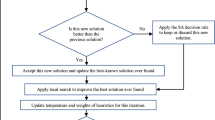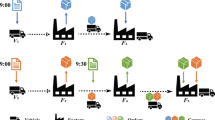Abstract
We consider a set of single-machine batch delivery scheduling problems involving two competing agents under two due date assignment models. Belonging to one of the two agents, each job is processed and delivered in a batch to its agent, where the jobs in each batch come from the same agent. The jobs in a batch are processed sequentially and the processing time of a batch is equal to the sum of the processing times of the jobs in it. A setup time is required at the start of each batch. The dispatch date of a job equals the delivery date of the batch it is in, i.e., the completion time of the last job in the batch. There is no capacity limit on each delivery batch, and the cost per batch delivery is fixed and independent of the number of jobs in the batch. The due date of each job is a decision variable, which is to be assigned by the decision maker using one of two due date models, namely the common and unrestricted due date models. Given the due date assignment model, the overall objective is to minimize one agent’s scheduling criterion, while keeping the other agent’s criterion value from exceeding a threshold given in advance. Two kinds of scheduling criteria are involved: (i) the total cost comprising the earliness, tardiness, job holding, due date assignment, and batch delivery costs; and (ii) the total cost comprising the earliness, weighted number of tardy jobs, job holding, due date assignment, and batch delivery costs. For each of the problems considered, we show that it is \(\mathcal {NP}\)-hard in the ordinary sense and admits a fully polynomial-time approximation scheme.



Similar content being viewed by others
References
Agnetis, A., Mirchandani, P. B., Pacciarelli, D., & Pacifici, A. (2004). Scheduling problems with two competing agents. Operations Research, 52, 229–242.
Agnetis, A., Pacciarelli, D., & Pacifici, A. (2007). Multi-agent single machine scheduling. Annals of Operations Research, 150, 3–15.
Ahmadizar, F., & Farhadi, S. (2015). Single-machine batch delivery scheduling with job release dates, due windows and earliness, tardiness, holding and delivery costs. Computers and Operations Research, 53, 194–205.
Assarzadegan, P., & Rasti-Barzoki, M. (2003). Minimizing sum of the due date assignment costs, maximum tardiness and distribution costs in a supply chain scheduling problem. Applied Soft Computing, 47, 343–356.
Baker, K. R., & Smith, J. C. (2003). A multiple-criterion model for machine scheduling. Journal of Scheduling, 6, 7–16.
Bilgen, B., & Çelebi, Y. (2013). Integrated production scheduling and distribution planning in dairy supply chain by hybrid modeling. Annals of Operations Research, 211, 55–82.
Chen, Z. L. (1996). Scheduling and common due date assignment with earliness-tardiness penalties and batch delivery costs. European Journal of Operational Research, 93, 49–60.
Chen, Z. L. (2010). Integrated production and outbound distribution scheduling: Review and extensions. Operations Research, 58(1), 130–148.
Cheng, T. C. E., & Gordon, V. S. (1994). Batch delivery scheduling on a single machine. Journal of the Operational Research Society, 45, 1211–1215.
Cheng, T. C. E., & Kahlbacher, H. G. (1993). Scheduling with delivery and earliness penalty. Asia-Pacific Journal of Operational Research, 10, 145–152.
Dover, O., & Shabtay, D. (2016). Single machine scheduling with two competing agents, arbitrary release dates and unit processing times. Annals of Operations Research, 238, 145–178.
Gerstl, E., Mor, B., & Mosheiov, G. (2017). Scheduling with two competing agents to minimize total weighted earliness. Annals of Operations Research, 253, 227–245.
Gordon, V., Proth, J. M., & Chu, C. (2002a). A survey of the state-of-the-art of common due date assignment and scheduling research. European Journal of Operational Research, 139, 1–25.
Gordon, V., Strusevich, V., & Dolgui, A. (2012). Scheduling with due date assignment under special conditions on job processing. Journal of Scheduling, 15, 447–456.
Hall, N. G., & Potts, C. N. (2003). Supply chain scheduling: Batching and delivery. Operations Research, 51, 566–584.
Hermann, J. W., & Lee, C. Y. (1993). On scheduling to minimize earliness-tardiness and batch delivery costs with a common due date. European Journal of Operational Research, 70, 272–288.
Kaminsky, P., & Hochbaum, D. (2014). Due-date quotation models and algorithms. In J. Y.-T. Leung (Ed.), Handbook of scheduling: Algorithms, models and performance analysis (pp. 20:1–20:22). Boca Raton: CRC Press.
Kovalyov, M. Y., Oulamara, A., & Soukhal, A. (2015). Two-agent scheduling with agent specific batches on an unbounded serial batching machine. Journal of Scheduling, 18, 423–434.
Li, F., Chen, Z. L., & Tang, L. (2017). Integrated production, inventory and delivery problems: Complexity and algorithms. INFORMS Journal on Computing, 29(2), 232–250.
Mor, B., & Mosheiov, G. (2011). Single machine batch scheduling with two competing agents to minimize total flowtime. European Journal of Operational Research, 215, 524–531.
Mor, B., & Mosheiov, G. (2017). A two-agent single machine scheduling problem with due-window assignment and a common flow-allowance. Journal of the Combinatorial Optimization, 33, 1454–1468.
Perez-Gonzalez, P., & Framinan, J. M. (2014). A common framework and taxonomy for multicriteria scheduling problem with interfering and competing jobs: Multi-agent scheduling problems. European Journal of Operational Research, 235, 1–16.
Sahni, S. K. (1976). Algorithms for scheduling independent tasks. Journal of the ACM, 23(1), 116–127.
Selvarajah, E., & Zhang, R. (2014). Supply chain scheduling to minimize holding costs with outsourcing. Annals of Operations Research, 217, 479–490.
Shabtay, D. (2010). Scheduling and due date assignment to minimize earliness, tardiness, holding, due date assignment and batch delivery costs. International Journal of Production Economics, 123, 235–242.
Steiner, G., & Zhang, R. (2009). Approximation algorithms for minimizing the total weighted number of late jobs with late deliveries in two-level supply chains. Journal of Scheduling, 12, 565–574.
Wang, D., Yin, Y., Cheng, S. R., Cheng, T. C. E., & Wu, C. C. (2016). Due date assignment and scheduling on a single machine with two competing agents. International Journal of Production Research, 54, 1152–1169.
Webster, S., & Baker, K. (1995). Scheduling groups of jobs on a single machine. Operations Research, 43, 692–703.
Woeginger, G. J. (2000). When does a dynamic programming formulation guarantee the existence of a fully polynomial time approximation scheme (FPTAS)? INFORMS Journal on Computing, 12, 57–75.
Yin, Y., Cheng, S. R., Cheng, T. C. E., Wang, D. J., & Wu, C. C. (2016a). Just-in-time scheduling with two competing agents on unrelated parallel machines. Omega, 63, 41–47.
Yin, Y., Cheng, T. C. E., Hsu, C. J., & Wu, C. C. (2013). Single-machine batch delivery scheduling with an assignable common due window. Omega, 41, 216–225.
Yin, Y., Cheng, T. C. E., Yang, X., & Wu, C. C. (2015). Two-agent single-machine scheduling with unrestricted due date assignment. Computers and Industrial Engineering, 79, 148–155.
Yin, Y., Wang, D., Wu, C. C., & Cheng, T. C. E. (2016b). \(CON/SLK\) due date assignment and scheduling on a single machine with two agents. Naval Research Logistics, 63, 416–429.
Acknowledgements
We thank the Editor, an Associate Editor, and two anonymous referees for their helpful comments on earlier versions of our paper. This paper was supported in part by the National Natural Science Foundation of China under Grant Numbers 11561036, 71501024, 71532007, and 71520107002; and in part by Project funded by China Postdoctoral Science Foundation under Grant Number 2017M612099. Cheng was supported in part by The Hong Kong Polytechnic University under the Fung Yiu King-Wing Hang Bank Endowed Professorship in Business Administration.
Author information
Authors and Affiliations
Corresponding author
Appendix: Proof of Lemma 5.4
Appendix: Proof of Lemma 5.4
Proof of Lemma 5.4
We prove the lemma by induction on j and k, respectively. It is clear that the lemma holds for (1, 0) or (0, 1). As the induction hypothesis, for any given k, we first assume that the lemma holds for any \(j=l-1\), i.e., for any eliminated label \((x,y,e_A,e_B,a_A,a_B,c_A,c_B,f^A,f^B)\in \mathcal {S}(j-1,k)\), there exists a label \((x,y,e_A,e_B,\widetilde{a}_A,\widetilde{a}_B,\widetilde{c}_A, \widetilde{c}_B,\widetilde{f}^A,\widetilde{f}^B)\) such that \(\widetilde{a}_A\ge a_A,\widetilde{a}_B\ge a_B,\widetilde{c}_A\le c_A,\widetilde{c}_B\le c_B\), \(\widetilde{f}^A\le \Delta ^{j+k}f^A\), and \(\widetilde{f}^B\le f^B\). We show that the lemma holds for \(j=l\).
Consider an arbitrary label \((x,y,e_A,e_B,a_A,a_B,c_A,c_B,f^A,f^B)\in \mathcal {S}(j,k)\), extended from a label in \(\mathcal {S}(j-1,k)\). Then \(f^B\le U^B\) must hold by the constraint. First, we assume that job \(J_j^A\) is scheduled as early in the corresponding partial schedule. While implementing Algorithm \(ConTAA_{\varepsilon }\), two cases need to be considered.
Case 1 \(x=1\). In this case, the label \((x,y,e_A,e_B,a_A,a_B,c_A,c_B,f^A,f^B)\) is constructed from \((0,y,0,e_B,a_A,a_B,c_A,c_B,f^A-n_A\gamma ^Ap_j^A-s^A-\varphi ^A,f^B)\in \mathcal {S}(j-1,k)\) if \(e_A=1\) and \(e_B=0\), and from \((1,y,e_A-1,e_B,a_A,a_B,c_A,c_B,f^A-(n_A\gamma ^A+e_A\theta ^A)p_j^A,f^B)\in \mathcal {S}(j-1,k)\) if \(e_A>1\). When \(e_A=1\) and \(e_B=0\), according to the induction hypothesis, there exists a label \((0,y,0,e_B,\widehat{a}_A,\widehat{a}_B,\widehat{c}_A,\widehat{c}_B,\widehat{f}^A,\widehat{f}^B)\in \mathcal {S}(j-1,k)\) such that \(\widehat{a}_A\ge a_A,\widehat{a}_B\ge a_B,\widehat{c}_A\le c_A,\widehat{c}_B\le c_B\), \(\widehat{f}^A\le \Delta ^{j+k-1}(f^A-n_A\gamma ^Ap_j^A-s^A-\varphi ^A)\), and \(\widehat{f}^B\le f^B\le U^B\). Then the label \((x,y,e_A,e_B,\widehat{a}_A,\widehat{a}_B,\widehat{c}_A,\widehat{c}_B,\widehat{f}^A+n_A\gamma ^Ap_j^A+s^A+\varphi ^A,\widehat{f}^B)\) will be generated during the label generation process. However, this label may be eliminated by another label \((x,y,e_A,e_B,\widetilde{a}_A,\widetilde{a}_B,\widetilde{c}_A,\widetilde{c}_B,\widetilde{f}^A,\widetilde{f}^B)\) through the elimination rules in Algorithm \(ConTAA_{\varepsilon }\). If it is eliminated by \((x,y,e_A,e_B,\widetilde{a}_A,\widetilde{a}_B,\widetilde{c}_A,\widetilde{c}_B,\widetilde{f}^A,\widetilde{f}^B)\) through elimination rule (1), we have \(\widetilde{a}_A\ge \widehat{a}_A\ge a_A,\widetilde{a}_B\ge \widehat{a}_B\ge a_B,\widetilde{c}_A\le \widehat{c}_A\le c_A,\widetilde{c}_B\le \widehat{c}_B\le c_B\), \(\widetilde{f}^A\le \Delta (\widehat{f}^A+n_A\gamma ^Ap_j^A+s^A+\varphi ^A)\le \Delta (\Delta ^{j+k-1}(f^A-n_A\gamma ^Ap_j^A-s^A-\varphi ^A)+n_A\gamma ^Ap_j^A+s^A+\varphi ^A)\le \Delta \Delta ^{j+k-1}f^A\le \Delta ^{j+k}f^A\), and \(\widetilde{f}^B\le \widehat{f}^B\le f^B\le U^B\). Otherwise, we have \(\widetilde{a}_A\ge \widehat{a}_A\ge a_A,\widetilde{a}_B\ge \widehat{a}_B\ge a_B,\widetilde{c}_A\le \widehat{c}_A\le c_A,\widetilde{c}_B\le \widehat{c}_B\le c_B\), \(\widetilde{f}^A\le \widehat{f}^A\le \Delta ^{j+k-1}f^A\le \Delta ^{j+k}f^A\), and \(\widetilde{f}^B=\widehat{f}^B\le f^B\le U^B\). Similarly, the result also holds for the case where \(e_A>1\).
Case 2 \(x=2\). In this case, the label \((x,y,e_A,e_B,a_A,a_B,c_A,c_B,f^A,f^B)\) is constructed from \((2,y,0,e_B,a_A,a_B,c_A,c_B,f^A-n_A\gamma ^Ap_j^A-s^A-\varphi ^A,f^B-n_B\gamma ^Bp_j^A)\in \mathcal {S}(j-1,k)\) if \(e_A=1\), and from \((2,y,e_A-1,e_B,a_A,a_B,c_A,c_B,f^A-(n_A\gamma ^A+e_A\theta ^A)p_j^A,f^B-n_B\gamma ^Bp_j^A)\in \mathcal {S}(j-1,k)\) if \(e_A>1\). Analogous to proof of Case 1, there exists a label \((x,y,e_A,e_B,\widetilde{a}_A,\widetilde{a}_B,\widetilde{c}_A,\widetilde{c}_B,\widetilde{f}^A,\widetilde{f}^B)\) such that \(\widetilde{a}_A\ge a_A,\widetilde{a}_B\ge a_B,\widetilde{c}_A\le c_A,\widetilde{c}_B\le c_B\), \(\widetilde{f}^A\le \Delta ^{j+k}f^A\), and \(\widetilde{f}^B\le f^B\le U^B\).
It follows that the induction hypothesis holds for \(j=l\) when job \(J_j^A\) is scheduled as early in the corresponding partial schedule.
Now, we turn to the case where job \(J_j^A\) is scheduled as tardy in the corresponding partial schedule. While implementing Algorithm \(ConTAA_{\varepsilon }\), two cases need to be considered.
Case 3 \(a_A=1\). In this case, the label \((x,y,e_A,e_B,a_A,a_B,c_A,c_B,f^A,f^B)\) is constructed from \((x,0,e_A,e_B,c,a_B,c,c_B,f^A-\beta ^A(c_A+l-1-e_A)p_j^A-s^A-\varphi ^A,f^B-\beta ^B(c_B+k-e_B-a_B)p_j^A)\in \mathcal {S}(j-1,k)\) if \(e_A=l-1\) and \(e_B=k\), and from \((x,y,e_A,e_B,c,a_B,c,c_B,f^A-\beta ^A(c_A+l-1-e_A)p_j^A-s^A-\varphi ^A,f^B-\beta ^B(c_B+k-e_B-a_B)p_j^A)\in \mathcal {S}(j-1,k)\) if \(e_A<l-1\) or \(e_B<k\) for some \(1\le c\le c_A\). When \(e_A=l-1\) and \(e_B=k\), according to the induction hypothesis, there exists a label \((x,0,e_A,e_B,\widehat{a}_A,\widehat{a}_B,\widehat{c}_A,\widehat{c}_B,\widehat{f}^A,\widehat{f}^B)\in \mathcal {S}(j-1,k)\) such that \(\widehat{a}_A\ge c,\widehat{a}_B\ge a_B,\widehat{c}_A\le c,\widehat{c}_B\le c_B\), \(\widehat{f}^A\le \Delta ^{j+k-1}(f^A-\beta ^A(c_A+l-1-e_A)p_j^A-s^A-\varphi ^A)\), and \(\widehat{f}^B\le f^B-\beta ^B(c_B+k-e_B-a_B)p_j^A)\), implying that \(\widehat{a}_A=\widehat{c}_A=c\) since \(\widehat{a}_A\le \widehat{c}_A\). Since \(\widehat{f}^B+\beta ^B(c_B+k-e_B-a_B)p_j^A\le f^B\le U^B\), the label \((x,y,e_A,e_B,1,\widehat{a}_B,c_A,\widehat{c}_B,\widehat{f}^A+\beta ^A(c_A+l-1-e_A)p_j^A+s^A+\varphi ^A,\widehat{f}^B+\beta ^B(c_B+k-e_B-a_B)p_j^A)\) will be generated during the label generation process since \(c\le c_A\). However, this label may be eliminated by another label \((x,y,e_A,e_B,\widetilde{a}_A,\widetilde{a}_B,\widetilde{c}_A,\widetilde{c}_B,\widetilde{f}^A,\widetilde{f}^B)\) through the elimination rules in Algorithm \(ConTAA_{\varepsilon }\). If it is eliminated by \((x,y,e_A,e_B,\widetilde{a}_A,\widetilde{a}_B,\widetilde{c}_A,\widetilde{c}_B,\widetilde{f}^A,\widetilde{f}^B)\) through elimination rule (1), we have \(\widetilde{a}_A\ge 1= a_A,\widetilde{a}_B\ge \widehat{a}_B\ge a_B,\widetilde{c}_A\le \widehat{c}_A=c\le c_A,\widetilde{c}_B\le \widehat{c}_B\le c_B\), \(\widetilde{f}^A\le \Delta (\widehat{f}^A+\beta ^A(c_A+l-1-e_A)p_j^A+s^A+\varphi ^A)\le \Delta (\Delta ^{j+k-1}(f^A-\beta ^A(c_A+l-1-e_A)p_j^A-s^A-\varphi ^A)+\beta ^A(c_A+l-1-e_A)p_j^A+s^A+\varphi ^A)\le \Delta \Delta ^{j+k-1}f^A\le \Delta ^{j+k}f^A\), and \(\widetilde{f}^B\le \widehat{f}^B+\beta ^B(c_B+k-e_B-a_B)p_j^A\le f^B\le U^B\). Otherwise, we have \(\widetilde{a}_A\ge 1= a_A,\widetilde{a}_B\ge \widehat{a}_B\ge a_B,\widetilde{c}_A\le c_A,\widetilde{c}_B\le \widehat{c}_B\le c_B\), \(\widetilde{f}^A\le \widehat{f}^A\le \Delta ^{j+k-1}f^A\le \Delta ^{j+k}f^A\), and \(\widetilde{f}^B=\widehat{f}^B\le f^B\le U^B\). Similarly, the result also holds for the case where \(e_A<l-1\) or \(e_B<k\).
Case 4 \(a_A>1\). In this case, the label \((x,y,e_A,e_B,a_A,a_B,c_A,c_B,f^A,f^B)\) is constructed from \((x,y,e_A,e_B,a_A-1,a_B,c_A,c_B,f^A-\beta ^A(c_A+l-e_A)p_j^A-a_A\theta ^Ap_j^A,f^B-\beta ^B(c_B+k-e_B-a_B)p_j^A)\in \mathcal {S}(j-1,k)\) if \(y=1\), and from \((x,y,e_A,e_B,a_A-1,a_B,c_A,c_B,f^A-\beta ^A(c_A+l-e_A)p_j^A-a_A\theta ^Ap_j^A,f^B-\beta ^B(k-e_B-a_B)p_j^A)\in \mathcal {S}(j-1,k)\) if \(y=2\). Analogous to proof of Case 3, there exists a label \((x,y,e_A,e_B,\widetilde{a}_A,\widetilde{a}_B,\widetilde{c}_A,\widetilde{c}_B,\widetilde{f}^A,\widetilde{f}^B)\) such that \(\widetilde{a}_A\ge a_A,\widetilde{a}_B\ge a_B,\widetilde{c}_A\le c_A,\widetilde{c}_B\le c_B\), \(\widetilde{f}^A\le \Delta ^{j+k}f^A\), and \(\widetilde{f}^B\le f^B\le U^B\).
It follows that the induction hypothesis holds for \(j=l\) when job \(J_j^A\) is scheduled as tardy in the corresponding partial schedule.
In a similar way, we can show that for any given j, the result holds for \(k=l\) when it is valid for any \(k=l-1\).
Thus, the induction hypothesis holds in each case and the result follows. \(\square \)
Rights and permissions
About this article
Cite this article
Yin, Y., Li, D., Wang, D. et al. Single-machine serial-batch delivery scheduling with two competing agents and due date assignment. Ann Oper Res 298, 497–523 (2021). https://doi.org/10.1007/s10479-018-2839-6
Published:
Issue Date:
DOI: https://doi.org/10.1007/s10479-018-2839-6




